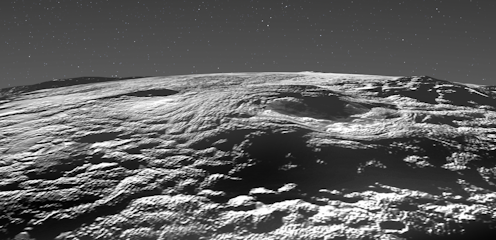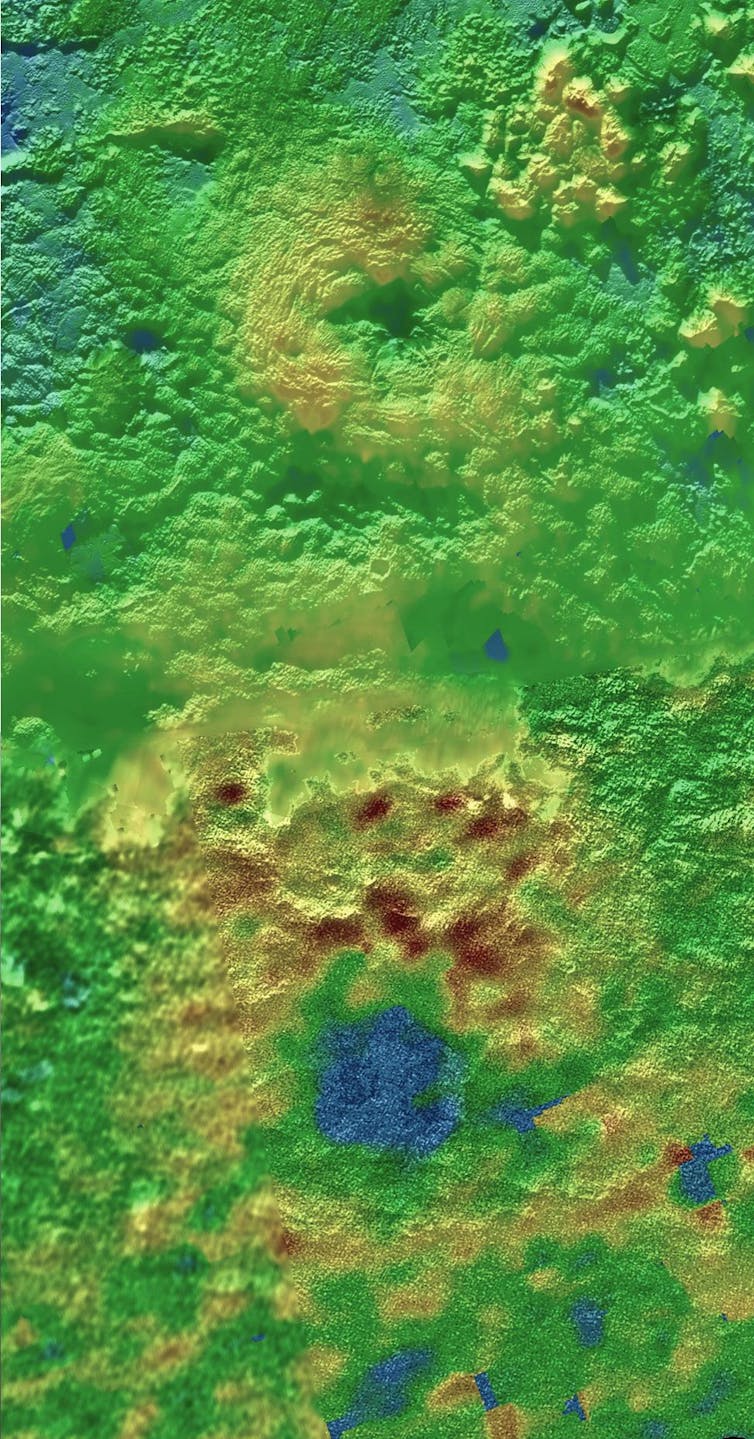
Pluto, the Solar System’s largest dwarf planet, just became even more interesting with a report that icy lava flows have recently covered substantial tracts of its surface. In this context, “recently” means probably no more than a billion years ago. That’s old, of course – and there is no suggestion that volcanoes are still active – but it’s only a quarter the age of the Solar System and no one knows how Pluto brewed up the heat needed to power these eruptions.
The news, coming nearly seven years after NASA’s New Horizons probe made its spectacular flyby of Pluto on July 14, 2015, is thanks to analysis of images and other data by a team led by Kelsi Singer of the Southwest Research Institute in Boulder, Colorado.
Singer’s team draw particular attention to a mountainous feature named Wright Mons, which rises 4-5km above its surroundings. It is about 150km across its base and has a central depression (a hole) 40-50km wide, with a floor at least as low as the surrounding terrain.
The team claims that Wright Mons is a volcano, and cite the lack of impact craters as evidence that it is not likely to be older than 1-2 billion years. Many other areas of Pluto have been around long enough to accumulate large numbers of impact craters – no recent icy lava flows have covered them.
As volcanoes go, Wright Mons is a big one. Its volume exceeds 20 thousand cubic kilometres. Although considerably less than the volume of Mars’s biggest volcanoes, this is similar to the total volume of Hawaii’s Mauna Loa, and much greater than the volume of its above sea-level portion. This is particularly impressive given Pluto’s small size, with a diameter about a third that of Mars and a sixth that of Earth.

The Wright stuff
In detail, the slopes of Wright Mons and much of its surroundings are seen to be crowded with hummocks up to 1km high and mostly 6-12km across. The team conclude that these hummocks are made primarily of water-ice, rather than nitrogen- or methane-ice that covers some other young regions on Pluto. They argue that this is consistent with the material strength necessary to form and preserve these domes, but they do recognise small patches of much weaker nitrogen-ice, mainly in the central depression.
The hummocks were likely created by some sort of ice volcanism, known by the technical term “cryovolcanism” – erupting icy water rather than molten rock. Pluto’s bulk density shows that it must have rock in its interior, but its outer regions are a mixture of ices (water, methane, nitrogen and probably ammonia and carbon monoxide, too, all of which are less than a third as dense as rock) in the same way that the crust of the Earth and other rocky planets is a mixture of several silicate minerals.

At Pluto’s surface temperature of well below -200°C, ice made of frozen water is immensely strong. It can (and on Pluto, does) form steep mountains that will last for eternity without sagging downhill like a glacier on the much less frigid Earth, where water-ice is weaker.
What melts the ice?
Ice, of course, melts at much lower temperatures than rock. And when there is a mixture of two ices, melting can begin at a lower temperature than for either of the pure ices (the same principle applies in silicate rock made of different minerals). This makes melting even easier. Despite this, it is a surprise to find evidence of relatively young water-rich cryovolcanic eruptions on Pluto, because there is no known heat source to power them.
There is only very limited scope for Pluto’s interior to be heated by tidal forces – a gravitational effect between orbiting bodies, such as a moon and a planet – which warm the interiors of some of the moons of Jupiter and Saturn. And the amount of rock inside Pluto is not enough to produce much heat from radioactivity.
Singer and her coworkers speculate that Pluto somehow held on to heat from its birth, which was unable to leak out until late in the body’s history. This would be consistent with Pluto having a deep internal liquid water ocean, suggested based on other evidence.
If the hummocks from which Wright Mons is built do represent water-ice eruptions, this stuff clearly was not flowing freely like liquid water, but must have been some kind of gooey crystal-rich “mush”, maybe within a completely frozen, but still pliable, outer skin that confined each effusion of fluid into a dome-like hummock.
A hole in the argument?
The team cite the depth and volume of the central depression of Wright Mons to dismiss earlier suggestions that this is a volcanic crater (a caldera) or that it has been excavated by explosive eruptions. Instead, they regard it as a gap that somehow avoided being covered by erupted hummocks.
I have my doubts about that, because there is an even bigger probable volcano, Piccard Mons, to the south of Wright Mons that also has a large central depression. It strikes me as too much of a coincidence for there to be two adjacent volcanoes both with fortuitous holes in their middles. I think it is more likely that these central depressions are somehow integral to how these volcanoes grew or erupted.

Piccard Mons is less well characterised than Wright Mons because, by the time New Horizons made its closest approach, Pluto’s rotation had carried Piccard Mons into darkness. The flyby was so fast that only the side of Pluto facing the Sun at the right time could be seen in detail. However, New Horizons was able to image Piccard Mons thanks to sunlight weakly reflected onto the ground by haze in Pluto’s atmosphere.
Leer más: NASA mission brings Pluto into sharp focus – but it's still not a planet
That was a remarkable achievement, but it leaves us wanting to know more. What extra details are lurking in the poorly imaged half of Pluto? It will probably be decades before we find out, or learn much more about how these icy volcanoes formed.
David Rothery is Professor of Planetary Geosciences at the Open University. He is co-leader of the European Space Agency's Mercury Surface and Composition Working Group, and a Co-Investigator on MIXS (Mercury Imaging X-ray Spectrometer) that is now on its way to Mercury on board the European Space Agency's Mercury orbiter BepiColombo. He has received funding from the UK Space Agency and the Science & Technology Facilities Council for work related to Mercury and BepiColombo, and from the European Commission under its Horizon 2020 programme for work on planetary geological mapping (776276 Planmap). He is author of Planet Mercury - from Pale Pink Dot to Dynamic World (Springer, 2015), Moons: A Very Short Introduction (Oxford University Press, 2015) and Planets: A Very Short Introduction (Oxford University Press, 2010). He is Educator on the Open University's free learning Badged Open Course (BOC) on Moons and its equivalent FutureLearn Moons MOOC, and chair of the Open University's level 2 course on Planetary Science and the Search for Life.
This article was originally published on The Conversation. Read the original article.






